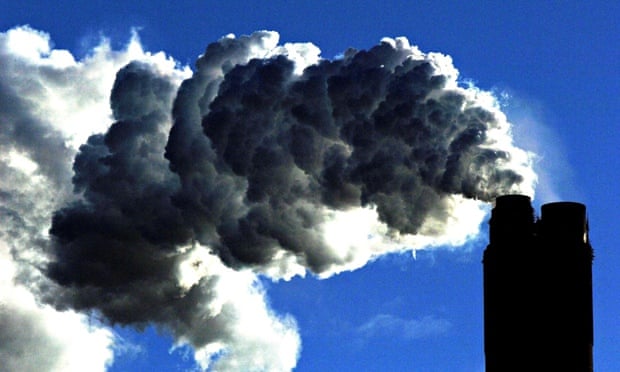Still no modelling to show whether Direct Action will meet emissions target
Environment department head tells estimates he cannot say whether climate policy can reduce greenhouse gas emissions by 5% of 2000 levels by 2020
Public servants are still unsure how the Coalition’s climate policy will meet Australia’s emissions reduction target and are basing their confidence on achieving the goal on the country’s past performance on environmental policy.

A coal-fired power station. The Coalition’s Direct Action has allocated $2.55bn to an emissions reduction fund, but there is not evidence that it will work in meeting its immediate target. Photograph: John Giles/PA
A Senate estimates hearing on Monday heard that the department of environment and clean energy regulator had not done any modelling to assess whether the newemissions reduction fund would meet Australia’s minimum target of a 5% reduction in emissions by 2020, based on 2000 levels.
The fund is the centrepiece of the Coalition’s $2.55bn Direct Action climate policy, which replaced carbon pricing last year. The fund will provide voluntary grants to businesses that wish to reduce their greenhouse gas emissions, with auctions set to begin in April.
However, Gordon de Brouwer, head of the department, told senators that he could not say whether the policy would be sufficient to meet the 5% target.
“It depends on how many factors of the emissions reduction fund are tied down and while the crediting and purchasing component is tied down by legislation, the safeguards component is still to be determined,” he said.
“Until that’s determined, we’re not in a position to say how all of these factors will deliver the 5% reduction, except to say the government has said it has the instruments to hand to deliver that.”
The “safeguards” component of the policy aims to ensure that emissions do not rise elsewhere in the economy, wiping out the gains of purchased emissions.
This will be done via a complex baseline accreditation system, which will work out the historical trends of firms that pump out more than 100,000 tonnes of greenhouse gases a year. How businesses will be penalised, if at all, for greatly increasing emissions is unclear, with the safeguards system not due to begin until 1 July 2016.
Despite this uncertainty, the government has repeatedly stressed its confidence in meeting the 5% goal. De Brouwer said this confidence was based on Australia’s past environmental record, rather than analysis of the emissions reduction fund’s prospects.
“The government’s position is that whenever Australia has made commitments of these kinds, such as the first Kyoto protocol period, that commitment was met, in fact more than met,” he said.
“It’s Australia’s practice to not make commitments it can’t deliver, so when it says it delivers the 5% [reduction] on 2000 levels by 2020, it will do so.”
De Brouwer said the “toolkit is there to do it” with the emissions reduction scheme now in place.
Government senator Simon Birmingham, a former parliamentary secretary for the environment, said “It may be that the ERF [emissions reduction fund] overshoots the target” when asked if the policy was sufficient to meet the 5% goal.
The government’s Climate Change Authority and the UN, along with other independent modelling, have all indicated that the emissions reduction fund will struggle to meet the 5% target, at least without significant extra investment.
However, environment minister Greg Hunt has pointed out that the decline in Australian manufacturing and energy efficiency measures means that the 5% task is falling, to around 421m tonnes of abated greenhouse gas by 2020.
Tony Abbott has declined to allocate more funds to the Direct Action plan, instead saying the government will “have a crack” at meeting the emissions reduction target.
During Monday’s senate estimates hearing, Coalition senator Matt Canavan criticised the lack of a cost-benefit analysis of Australia’s efforts to reduce emissions.
“We’ve probably spent north of $20bn and we don’t know what impact we’ve had,” he said. “How much has that altered the temperature of the globe?”
Department of environment officials said no such figures had been calculated.
Data released by the government in December showed that Australia’s greenhouse gas emissions dropped 1.4% in the second full year of the carbon price – the largest recorded annual decrease in the past decade. Australia’s total emissions stood at 542.6m tonnes in the year to June 2014, with the carbon price abolished a month later.
Comments